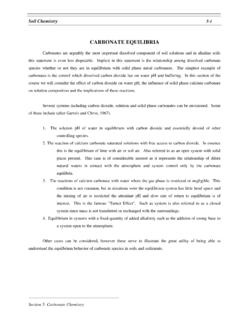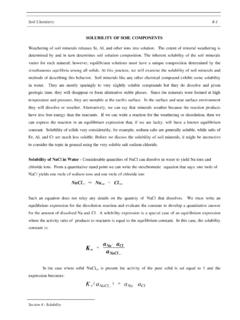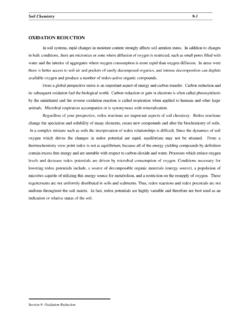Transcription of CARBONATE EQUILIBRIA
1 Soil Chemistry5-1 Section 5- CARBONATE Chemistry CARBONATE EQUILIBRIAC arbonates are arguably the most important dissolved component of soil solutions and in alkaline soilsthis statement is even less disputable. Implicit in this statement is the relationship among dissolved carbonatespecies whether or not they are in equilibrium with solid phase metal carbonates. The simplest example ofcarbonates is the control which dissolved carbon dioxide has on water pH and buffering. In this section of thecourse we will consider the effect of carbon dioxide on water pH, the influence of solid phase calcium carbonateon solution composition and the implications of these systems including carbon dioxide, solution and solid phase carbonates can be envisioned.
2 Someof these include (after Garrels and Christ, 1967).1. The solution pH of water in equilibrium with carbon dioxide and essentially devoid of othercontrolling species. 2. The reaction of calcium CARBONATE saturated solutions with free access to carbon dioxide. In essencethis is the equilibrium of lime with air or soil air. Also referred to as an open system with solidphase present. This case is of considerable interest as it represents the relationship of dilutenatural waters in contact with the atmosphere and system control only by the The reactions of calcium CARBONATE with water where the gas phase is restricted or negligible. Thiscondition is not common, but in situations were the equilibrium system has little head space andthe mixing of air is restricted the attendant pH and slow rate of return to equilibrium is ofinterest.
3 This is the famous "Turner Effect". Such as system is also referred to as a closedsystem since mass is not transferred or exchanged with the Equilibrium in systems with a fixed quantity of added alkalinity such as the addition of strong base toa system open to the cases can be considered, however these serve to illustrate the great utility of being able tounderstand the equilbrium behavior of CARBONATE species in soils and sediments. Soil Chemistry5-2 Section 5- CARBONATE Chemistry CASE 1 CO2 - H2O open systemAqueous carbon dioxide reacts to form carbonic acid via the following (aq) (aq) + HO COCOH COH = 10CO =The hydration of carbon dioxide is slow to attain equilibrium below pH 8 in pure systems.
4 However,above pH 11, the hydration reaction is relatively rapid as carbon dioxide reacts directly with hydroxide to (aq) + OH- = HCO3- (1)In biological systems the hydration of carbon dioxide is catalyzed by carbonic anhydrase a Zn-containingenzyme. Only a small portion of the aqueous carbon dioxide exists as carbonic acid. However, in most H2CO3*(as defined below) is used to represent solution carbonates. *2332(aq)2 = + HCOCOCOH(2)Where H2CO3* is the total dissolved cabon including aqueous carbon acid dissociates into bicarbonate and CARBONATE according to the following equations:23-+3- ( ) ( )HCOH = = 10K( )COH(3)where H2CO3 = H2CO3 + CO2 (aq) = H2CO3*Note that KoH2CO3 = 2*10 -4 or pK = if corrected for CO2(aq) Soil Chemistry5-3 Section 5- CARBONATE Chemistry -32-+3o - ( ) ( )COH = = 10K( )HCO(4)As for every aqueous reaction the acid base relationship between the proton and hydroxide is an +- 14oW() ()OHH = = 10K( HO )(5)Starting with the electrical neutrality expression.
5 23]--+3[ ] = [ ] + [ ] + 2 [ COOHHCOH (6)The system is manipulated to collect terms in the variables of interest - hydrogen ion concentration andcarbon dioxide partial pressure. Note that the electrical neutrality expression is defined in terms of concentrations(mol/L). Therefore, in order to utilize values from the thermodynamic equilibrium expressions, the conditionalequilibrium constants must be used which relate concentrations rather than activities to the ionic distributions atequilibrium. 23(7)(8)-3-+cW-+-3c23 HCO-3+-c3 HCO2 -3+Defining in terms of yields:OHH K [ ] = OH[ ]H Solving for gives:HCO [ ]COKH [ ] = HCO[]H Finding CARBONATE via bicarbonate: [ ]HCOK [ ] = CO[]H(9) Soil Chemistry5-4 Section 5- CARBONATE Chemistry -233cc23 COHHCO- 2 -33 2+ []COKKHS ubstituting for : [ ] = HCOCO[]H(10)The rewritten electrical neutrality expression in terms of H+ and H2CO3 is.
6 -23233cccc23 COH23 WCOHCOH+ 2+++ [ ]CO []KKHCOKHK[ ] = + + 2 H[][][]HHH (11)Rearranging, multiplying by (H+) 2 and substituting kH * PCO2 for H2CO3 yields:()-2232323-2232323 3+c+c+ccWHHCOCOCOCOHHHCO 3++ccccwHHCOCOCOCOHHHCO[ - [ ] - [] - 2 = 0 ]kkHKHKHPKKP[ - [] + - 2 = 0]kkHHKKPKKP(12)We are left with a polynomial equation in [H+]. In this formulation the only variables are (H+) andPCO2. If a known and constant value for the partial pressure of carbon dioxide is inserted into the above equation,(H+) can be found by a variety of numerical techniques.
7 Henry's Law Constant for this reaction is strongly influenced by temperature and slightly affected byionic Level kH@ 298 KoLog M M M oK kH @ M NaClLog kH @ M NaCl273 Soil Chemistry5-5 Section 5- CARBONATE Chemistry Dissolved carbon is distributed among three species H2CO3, HCO3 and CO3 as a function of pH. In soil systemswhere there may be an external (to the CARBONATE system) control on pH it would be handy to know thedistribution of the CARBONATE species given pH. This distribution of CARBONATE species can be derived from theHenderson-Hasslebach relationship knowing pH and pK s. A slightly different approach is shown next.
8 Assume : CT = the sum of all CARBONATE species concentrationactivity coefficients are neglected or equal to z as: z = (H+)2 + (H+) KH2CO3 + KH2CO3 KHCO3 or more generally as:z = (H+) 2 + (H+) K1 + K1 K2 where K1 and K2 are the first and second dissociationconstants for the :+223T[ ][ ]COHH = CZ(13) -+13T[ ][ ] HCOHK = CZ(14) 2312[]THCOKKCZ=(15)Figure The distribution of CARBONATE species as a fraction of total dissolved CARBONATE in relation tosolution pH2468101214 n = ( H2-nCO3/ CT) Soil Chemistry5-6 Section 5- CARBONATE Chemistry Figure The activity of CARBONATE species in relation to pH for a carbon dioxide level activity of CARBONATE species-10-8-6-4-202 Pco2 = Soil Chemistry5-7 Section 5- CARBONATE Chemistry Figure.
9 The activity of CARBONATE species in relation to pH for a carbon dioxide level of1 Reactions in the CO2-H2O No. Equilibrium ReactionLog Ko1. CO2(g) + H2O W H2CO3o - H2CO3o W H+ + HCO3- - HCO3-W H+ + CO32-- CO2(g) + H2O W H+ + HCO3- - CO2(g) + H2O W 2 H+ + CO32-- activity of CARBONATE species-10-8-6-4-202 Pco2 = 1 atmH2CO3oHCO3-CO32- Soil Chemistry5-8 Section 5- CARBONATE Chemistry Figure Effect of carbon dioxide partial pressure on the solution concentration of CARBONATE species in theCO2-water system. - Log P CO20246810- Log C -16-14-12-10-8-6-4-20CO32-H+H2CO3 HCO3-HCO3- & H+ALKALINITYE xamination of Figure indicates that as the carbon dioxide partial pressure goes to zero, the solution pHapproaches 7 and increasing pressures of carbon dioxide cause the system to be acidic.
10 Therefore, in the CO2-water system there is never a net excess of base. The system can neutralize added base, but can not neutralizeadded acid. Another way of saying the same thing is to state that the system do not contain any alkalinity. Alkalinity is an important concept in solution chemistry and relates to the acid neutralization capacity of solutions. The definition of alkalinity for the CO2-water system is:233[][]2[][]AlkalinityOHHCOCOH +=++ (16) In the CO2 -water system the electrical neutrality condition for the system is:233[][][]2[]HOHHCOCO+ =++(17)Substituting the electrical neutrality equation into the alkalinity definition : Soil Chemistry5-9 Section 5- CARBONATE Chemistry 223333[][]2[][][]2[]AlkalinityOHHCOCOOHH COCO =++ (18)Therefore, there is no alkalinity in a CO2-water system, unless other sources of base are 2.





